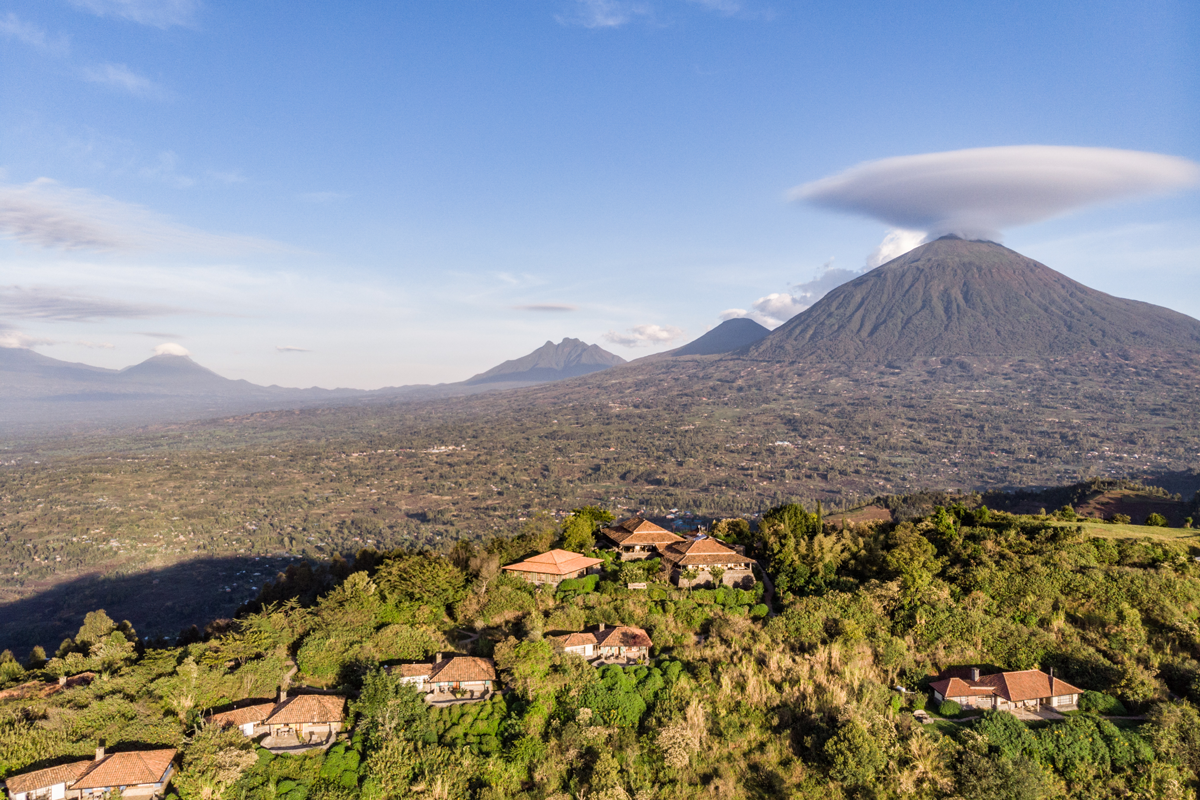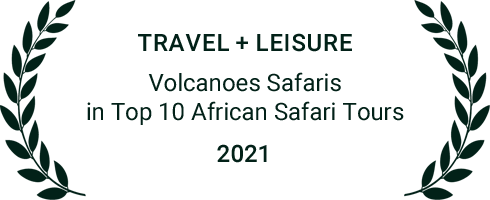Carefully placing each hand and foot, I moved slowly but deliberately up the handmade ladders nailed into the 60-degree mountain slope. On both sides, the ridge fell off into a white void. As if clawing my way to heaven, I followed the knife-edge path onward and upward through a sea of swirling white clouds to reach my final destination. As I drew closer, the clouds parted, revealing the volcano's fluted, emerald green spires. Lush vegetation—flowers blooming with delicate pink and yellow buds and trees with comical star-burst foliage—clinged to even the steepest slopes. In a flash of red and blue, a Rwenzori turaco burst through the mist and then disappeared into the valley below. It may not be heaven, but the landscape seemed to bear an uncanny resemblance to the Eden of my imagination.
From the summit of Mt. Sabyinyo, a 3,645-meter extinct volcano set in the heart Central Africa's Virunga Volcano range, I could place one foot in Rwanda, another in Uganda, and my right hand in the Democratic Republic of Congo (DRC). With the sky clear, I could view the entire range, which encompasses one of the last strongholds of the highly endangered mountain gorilla.
Most everyone who visits the Virunga Massif—which is composed of Volcanoes National Park in Rwanda, Virunga National Park in DRC, and Mgahinga National Park in Uganda—comes to trek to the mountain gorillas. However, few take advantage of the Massif’s volcano treks. There are eight volcanoes in the region, 6 of which can be summited, including Sabyinyo. With its seemingly vertical slopes, Sabyinyo appears unclimbable from Rwanda and DRC. However, the Uganda Wildlife Authority (UWA) maintains a solid trail (no ropes or specialized gear required) that departs from the Mgahinga National Park headquarters just up the road from Volcanoes Safaris’ Mgahinga Lodge.
Sabyinyo is my top volcano trek recommendation to fit travelers who aren’t afraid of heights (the steep drop offs near the top of the volcano can be vertigo-inducing). Permits to climb the volcano cost only $50 per person and can generally be obtained on short notice. Come to the park headquarters by 8am on the morning of your trek with plenty of water and food for the day (see my recommended gear list in my blog Five Tips for Gorilla Trekking). Your UWA guide will brief you about the day ahead. Most trekkers can complete the hike in 8 hours—five hours to summit and three to descend.
After walking through a flat swampy area, the first part of the ascent entails a moderately steep climb through the rainforest to the top of the lowest peak. Unlike gorilla trekking, you’ll be hiking along a well established trail, not bush-whacking. Things gets very interesting after the first peak. The forest falls away as you begin the steep climb up the serrated teeth of Sabyinyo’s knife-edge ridge. Most of the way the trail is so steep you will be climbing up wooden ladders nailed into the ridge. I found the views from these ladders so exhilarating my fatigue and fear of falling melted away completely. Bosco, my Ugandan porter, kept asking me to slow down as I scrambled up each ladder, inching closer to the top.
While Sabyinyo seemed massive as I climbed it, I saw from the summit that the volcano, and in fact the entire wilderness area, was not so very big. As if cut from cloth, the brilliant green patch of the Virunga Volcanoes was surrounded by paler green and brown patches of human settlement stretching to the horizon. The Virunga wilderness area is truly an island refuge for endangered plant and animal species with the tide of humanity lapping at its shores. I felt deeply privileged to be one of the few travelers to have reached the heart of the island. It’s there you can fully grasp how important it is to protect what’s left. I’m happy the money I paid to visit this place goes towards its conservation.




















